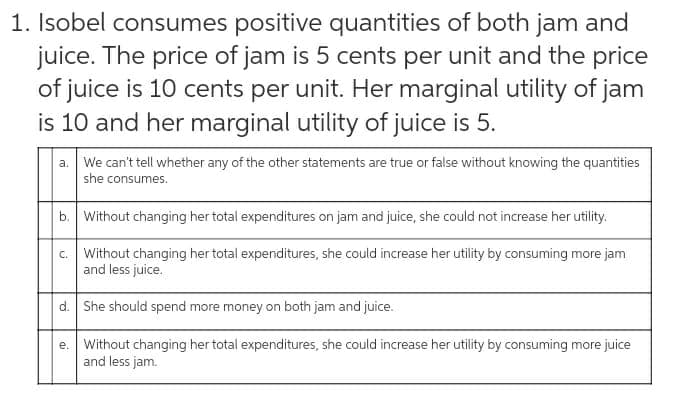1. Isobel consumes positive quantities of both jam and juice. The price of jam is 5 cents per unit and the price of juice is 10 cents per unit. Her marginal utility of jam is 10 and her marginal utility of juice is 5. a. We can't tell whether any of the other statements are true or false without knowing the quantities she consumes. b. Without changing her total expenditures on jam and juice, she could not increase her utility. c. Without changing her total expenditures, she could increase her utility by consuming more jam and less juice. d. She should spend more money on both jam and juice. e. Without changing her total expenditures, she could increase her utility by consuming more juice and less jam.
1. Isobel consumes positive quantities of both jam and juice. The price of jam is 5 cents per unit and the price of juice is 10 cents per unit. Her marginal utility of jam is 10 and her marginal utility of juice is 5. a. We can't tell whether any of the other statements are true or false without knowing the quantities she consumes. b. Without changing her total expenditures on jam and juice, she could not increase her utility. c. Without changing her total expenditures, she could increase her utility by consuming more jam and less juice. d. She should spend more money on both jam and juice. e. Without changing her total expenditures, she could increase her utility by consuming more juice and less jam.
Economics: Private and Public Choice (MindTap Course List)
16th Edition
ISBN:9781305506725
Author:James D. Gwartney, Richard L. Stroup, Russell S. Sobel, David A. Macpherson
Publisher:James D. Gwartney, Richard L. Stroup, Russell S. Sobel, David A. Macpherson
Chapter20: Consumer Choice And Elasticity
Section: Chapter Questions
Problem 4CQ
Related questions
Question

Transcribed Image Text:1. Isobel consumes positive quantities of both jam and
juice. The price of jam is 5 cents per unit and the price
of juice is 10 cents per unit. Her marginal utility of jam
is 10 and her marginal utility of juice is 5.
a. We can't tell whether any of the other statements are true or false without knowing the quantities
she consumes.
b. Without changing her total expenditures on jam and juice, she could not increase her utility.
c. Without changing her total expenditures, she could increase her utility by consuming more jam
and less juice.
d. She should spend more money on both jam and juice.
e. Without changing her total expenditures, she could increase her utility by consuming more juice
and less jam.
Expert Solution
This question has been solved!
Explore an expertly crafted, step-by-step solution for a thorough understanding of key concepts.
This is a popular solution!
Trending now
This is a popular solution!
Step by step
Solved in 2 steps

Knowledge Booster
Learn more about
Need a deep-dive on the concept behind this application? Look no further. Learn more about this topic, economics and related others by exploring similar questions and additional content below.Recommended textbooks for you

Economics: Private and Public Choice (MindTap Cou…
Economics
ISBN:
9781305506725
Author:
James D. Gwartney, Richard L. Stroup, Russell S. Sobel, David A. Macpherson
Publisher:
Cengage Learning

Microeconomics: Private and Public Choice (MindTa…
Economics
ISBN:
9781305506893
Author:
James D. Gwartney, Richard L. Stroup, Russell S. Sobel, David A. Macpherson
Publisher:
Cengage Learning

Exploring Economics
Economics
ISBN:
9781544336329
Author:
Robert L. Sexton
Publisher:
SAGE Publications, Inc

Economics: Private and Public Choice (MindTap Cou…
Economics
ISBN:
9781305506725
Author:
James D. Gwartney, Richard L. Stroup, Russell S. Sobel, David A. Macpherson
Publisher:
Cengage Learning

Microeconomics: Private and Public Choice (MindTa…
Economics
ISBN:
9781305506893
Author:
James D. Gwartney, Richard L. Stroup, Russell S. Sobel, David A. Macpherson
Publisher:
Cengage Learning

Exploring Economics
Economics
ISBN:
9781544336329
Author:
Robert L. Sexton
Publisher:
SAGE Publications, Inc



Principles of Economics 2e
Economics
ISBN:
9781947172364
Author:
Steven A. Greenlaw; David Shapiro
Publisher:
OpenStax